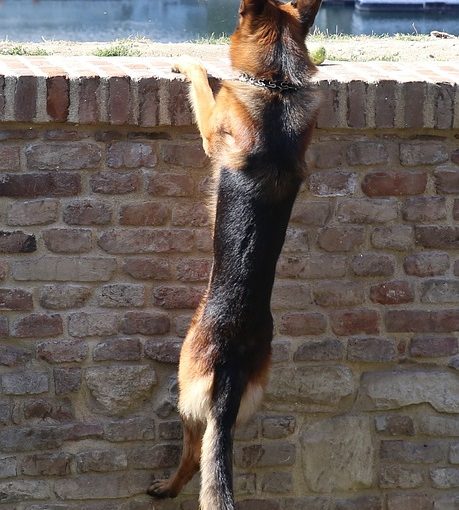German Shepherds are athletic and energetic dogs that can run long distances if they are physically fit. They can run 10-15 miles in a single session, but it’s important to gradually build up and listen to their body.
Factors like age, fitness level, temperature, and terrain should be considered when running with your dog. A healthy adult German Shepherd can run 3-5 miles at a moderate pace, and some can run even further.
Consult your veterinarian to ensure your dog’s physical capabilities and start with short runs. Proper conditioning is also essential to prevent injuries.
Benefits of Running with Your German Shepherd
Some of the benefits of running with your German Shepherd include;
Fosters strong friendship
Spending quality time together and fostering a stronger friendship with your dog can be achieved through running. It strengthens your relationship with your dog and serves as more than simply a workout for them.
Releases excess energy
Running helps dogs release excess energy, promoting a calmer home environment. It also keeps dogs fit and trim, and burning off excess energy is a great way to promote a more relaxed German Shepherd.
Reduces stress
Running with your German Shepherd can reduce stress by releasing endorphins, improving mood and providing fresh air and Vitamin D from sunshine, benefiting both humans and dogs.
Find new locations
In addition, running can be a terrific way to find new locations for you and your partner to play and explore around your neighborhood.
Prevent destructive habits
Keeping your German Shepherd engaged and active, running with them will help prevent destructive habits like digging and gnawing, which are frequently brought on by boredom and excess energy.
Improves health
By strengthening bone density, lowering the risk of diabetes and obesity, and improving cardiovascular health, running is good for both you and your dog’s health.
Keep you motivated
It is beneficial for you and your dog to run together, as it helps keep you motivated and consistent in achieving your fitness objectives.
To enhance your health and bond with your German Shepherd, consider joining them on the pavement for a fun and rewarding exercise routine. This will allow you to spend quality time together and potentially lead to some adventures.
Next Post: Can German Shepherds Eat Grapes?
Risks of Running with Your German Shepherds
German Shepherds face serious risks from heat stroke, injuries like strains, sprains, and fractures, and common health issues like elbow dysplasia, eye problems, and digestive issues.
To prevent these, ensure your dog is well-hydrated and chooses an appropriate running surface. It’s crucial to be aware of these risks.
Here’s a list of risks associated with running for German Shepherds:
- Heat stroke
- Injuries, such as strains, sprains, and fractures
- Over-exertion
- Dehydration
- Exertional rhabdomyolysis (a breakdown of muscle tissue due to strenuous exercise)
- Heart problems
- Hip dysplasia
- Pneumonia
Heat stroke
Heat stroke is a severe condition resulting from a dog’s overheating, causing symptoms like excessive panting, breathing difficulties, and lethargy. If you suspect your dog is suffering, seek immediate veterinary help.
Injuries
Running is beneficial for your German Shepherd’s health, but it’s important to be aware of potential injuries like strains, sprains, and fractures due to excessive speed, duration, or uneven surfaces. Warm up your dog before, gradually increase run length and speed, and cool them down afterward.
Over-exertion
Overexertion in dogs can lead to serious health issues like breathing difficulties, increased heart rate, and muscle pain. Recognize signs and stop exercising, gradually increasing length and speed with your dog.
Dehydration
Dehydration is a significant risk for dogs, especially German Shepherds due to their thick fur and high energy levels. Signs include excessive panting, dry gums, and sunken eyes. Offer water, ice cubes, or frozen treats to help. If severe, take your dog to the vet for treatment.
Exertional rhabdomyolysis
Exercise-induced muscle breakdown in dogs can cause rhabdomyolysis, causing symptoms like weakness, stiffness, and dark urine. If suspected, consult a vet for treatment, which may involve IV fluids and medication. Preventive measures include proper conditioning and slow running.
Heart problems
German shepherds may be susceptible to heart problems like congenital heart defects and dilated cardiomyopathy (DCM), which can affect blood flow and heart function, potentially leading to running complications. Regular exercise is beneficial for heart health, but it should be tailored to your dog’s individual needs and follow the veterinarian’s advice.
Hip dysplasia
This is a condition that affects the hip joint, causing pain and stiffness. It can be a serious problem, but there are treatments available to help manage the condition.
Pneumonia
German shepherds are at risk of pneumonia, a lung infection caused by viruses, bacteria, or foreign objects. Symptoms include coughing, difficulty breathing, and lethargy. Veterinarians can treat with antibiotics, fluid therapy, and rest. Consult for advice on dog health.
To ensure your German Shepherd’s safety during running, maintain a safe pace, hydrate properly, and consult with your veterinarian. Take precautions like training, wearing appropriate gear, and taking breaks.
Consider your dog’s health and fitness level when planning a run. Enjoy bonding and exercising with your dog while being aware of potential risks.
Safety Tips to Consider before Running with your German Shepherd
The safety of your German Shepherd is of utmost importance when running.
Safety tips to consider are;
- Start slow and build up gradually.
- Ensure running in a safe area, such as a park or open space, and monitor for potential hazards.
- To ensure hydration, it is essential to provide ample water for both you and your German Shepherd.
- Avoid extreme temperatures.
- It is crucial to ensure that breaks are taken as needed.
- Pay attention to your dog’s body language and stop if they show signs of discomfort.
This guideline emphasizes the importance of safety and health for your German Shepherd while promoting fun and team bonding through running.
What to do When your German Shepherd gets Injured while Running
If your German Shepherd gets injured while running, follow these steps;
- Stop running and assess the injury.
- Look for signs of swelling, bleeding, or lameness.
- Clean the area with water and apply a cold compress if the injury is minor.
- Provide your dog with plenty of rest and love.
- If your dog’s injury is severe, it’s crucial to seek veterinary care. Following your veterinarian’s treatment recommendations is crucial, as injuries can be challenging to assess, especially if your dog is hiding pain. Consultation is always recommended for proper diagnosis and treatment.
Training Tips for Running with Your German Shepherd
By following the appropriate precautions, you and your German Shepherd can enjoy a lifetime of happy and healthy running together.
Let’s now delve into some training tips.
- To train your German Shepherd to run, start with short, slow jogs around the block, gradually increasing speed and distance as your dog becomes more accustomed to running.
- Positive reinforcement, such as treats and praise, is crucial for fostering good behavior and making the dog’s experience enjoyable.
- Maintaining proper conditioning is crucial, ensuring your dog doesn’t get too much exercise and allowing them sufficient rest and recovery between runs.
- During a run with your German Shepherd, monitor their body language and energy levels. If they’re panting, seem lethargic, or show pain, stop and give them a break.
- Running in extreme heat or cold can be dangerous for your dog. Choose cooler times in the morning or evening, dress your dog appropriately in cold weather, and monitor for signs of frostbite or hypothermia.
- When running with your German Shepherd, ensure to take care of your body by wearing comfortable shoes, bringing water, and warming up and cooling down properly before and after the run.
- The most crucial point is to enjoy the time you spend running with your German Shepherd.
Other Fun Activities you can Enjoy with your German Shepherd
Engaging your German Shepherd in enjoyable activities like running, games, teaching tricks, and interactive toys not only provides physical benefits but also keeps their mind active, fostering a strong bond between you and your dog.
Let’s explore some of these activities now.
-
Agility training
Agility is a sport that involves guiding your dog through obstacles like tunnels, jumps, and weaving poles, fostering bonding with your German Shepherd, improving obedience and focus, and burning off excess energy to keep your dog fit and healthy.
-
Nose work
Nose work is a fun activity that uses your dog’s sense of smell to find hidden items, engaging their instincts and providing mental stimulation. It builds trust and bonding with your dog and can be easily set up at home with simple items.
-
Long walks or hikes
Engaging your German Shepherd in long walks or hikes can provide fresh air and new experiences. However, ensure to bring water, and snacks, and check the weather forecast before embarking on such activities, as it’s a great way to bond with your dog.
-
Puzzle toys
Puzzle toys are a great option for dogs, as they require them to figure out how to get treats, providing hours of entertainment and preventing boredom and destructive behaviors.
-
Play fetch
Playing fetch is a great way to exercise and bond with your German Shepherd. It’s a classic game that keeps them physically and mentally stimulated. However, use a safe chewable toy and ensure it’s large enough to prevent choking. Play in a safe space where your dog can run and play freely.
-
Tricks
Training your German Shepherd to perform tricks can foster a strong bond between you and your dog, provide mental stimulation, and keep their mind active. Some easy tricks to start with include “sit”, “shake”, and “roll over”.
-
Snuffle mats
Snuffle mats are a fun and easy way to engage your dog by using their sense of smell to find hidden treats, making them a great way to keep them entertained while you’re working on other tasks.
-
Sign up for a class
To keep your German Shepherd’s mind active, enroll in an obedience class. This bonding experience allows you to learn new skills together and build on your dog’s repertoire of tricks. Many obedience classes also teach tricks.
Frequently Asked Questions About How Many Miles A German Shepherd Can Run
What are the Most Common Injuries that German Shepherds can Sustain from Running?
Common injuries in dogs include soft tissue and joint injuries like sprains and hip dysplasia. Preventing these can be achieved by properly conditioning the dog for running and taking breaks as needed.
How Can I Prevent My German Shepherd from Getting Injured while Running?
To prevent injuries, gradually increase distance and speed, take breaks, and avoid running on hard surfaces. Ensure your dog is well-conditioned and in good health before starting a running program and consult your veterinarian.
How Can I Tell If My German Shepherd is Getting Too Tired While Running?
Observe your dog’s signs of exhaustion, such as slowing down, heavy breathing, and lagging behind, and give them a rest. Respect their limits and listen to their cues to avoid pushing them too hard, as this can lead to injury or heat exhaustion.
What do I do if my German Shepherd gets Injured while Running?
If your dog sustains an injury, stop running and assess the damage. If minor, you can continue running after resting and icing the affected area. If serious, consult a veterinarian and avoid self-diagnosis or treatment, as this can worsen the injury.
What are Some other things I Should Keep in Mind when Running with My German Shepherd?
When running with your dog, ensure they have access to water and can drink as much as they need. Avoid running in extreme temperatures as it can be dangerous. Lastly, use a leash, even if your dog is well-trained, for their safety and the safety of others around you.
Conclusion
A German Shepherd’s running ability depends on their age, health, fitness level, and personality. With proper training and precautions, they can enjoy running for years.
A healthy, fit German Shepherd can run 5-10 miles, starting with shorter distances and gradually increasing to avoid injuries. Listen to your dog and stop if they show signs of fatigue or discomfort. Running is an exercise and bonding experience for both you and your dog.




